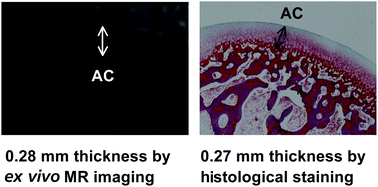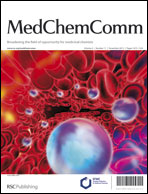Design, synthesis, and preliminary ex vivo and in vivo evaluation of cationic magnetic resonance contrast agent for rabbit articular cartilage imaging†
Abstract
Since early-stage diagnosis of osteoarthritis (OA) is necessary to retard the progress of the disease, magnetic resonance (MR) and computed tomography (CT) imaging agents have been applied to evaluate the integrity of the extracellular matrix (ECM) in the articular cartilage (AC). Although several negatively charged contrast agents were employed, they provided indirect images of the AC based on the coulombic repulsion with anionic glycosaminoglycans (GAGs) in the ECM. To achieve direct imaging of the ECM, positively charged contrast agents have quite recently been designed for optical and CT imaging. In this paper, we report on a positively charged MR contrast agent, DOTA-Gd-G2R8, which was applied preliminarily to ex vivo and in vivo imaging of rabbit AC. In the ex vivo imaging, the contrast agent was accumulated in the AC in high concentration due to the strong coulombic attraction between the negative charge of the GAGs and the positive charge of the octaarginine (R8). The thickness of the AC measured in the MR image was found to be comparable to that determined by the histological staining of the slice. The AC was also observed in vivo by MR imaging with the use of DOTA-Gd-G2R8.


 Please wait while we load your content...
Please wait while we load your content...